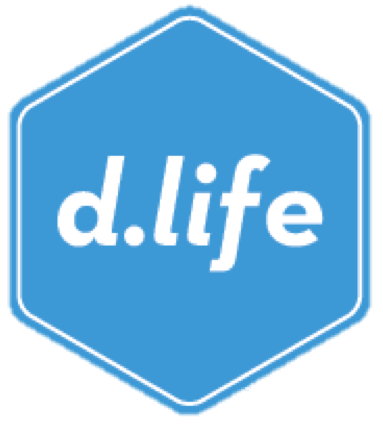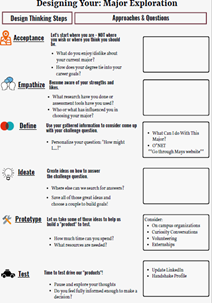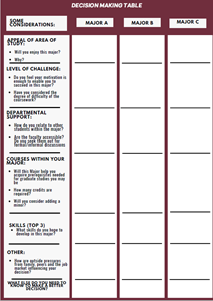The Power of Design Thinking Tools in Career Coaching
Yasir Kurt, Associate Director of Career Management at Purdue University Krannert School of Management shares how he and his team have used Design Thinking (DT) frameworks and mindsets in one-on-one coaching sessions.
Deciding what to study in college is vital and yet there are still lots of undecided students; some also do not have any idea why they are studying their majors. Therefore, my colleague Elena Aguinaga and I created design thinking (DT) tools to support decision making in our “major exploration” sessions. We also created design tools for student appointments about networking, job search strategies, career exploration, resume/cover letter development, and more.
Intended Outcome
Our goal: To create design thinking and life design tools to help students to articulate their perceptions and thought process and aid their ability to think critically. These tools also allow students to unlock their creative and empathic mindsets, encouraging them to challenge the way they would normally solve problems and contextualize their full story and decision-making process. Finally, the implementation of these tools is intuitive and simple, relying on a flexible dialog between career coaches and students to build upon the guided reflection aimed at exploration of the informed decision-making regarding major choices.
Exposure Strategy
Part of the effectiveness of our use of life design and design thinking tools in our career coaching lies in exposing students to design early and often. First, we introduce the design thinking framework and mindsets to all incoming freshmen through orientation presentations. Some instructors implement design tools in their three credit First Year Seminar course. We are also working on a more intentional strategy of introductory design thinking presentations/workshops to expose students to life design tools in advance of coming to 1:1 advising appointments. Through this early exposure, students get familiar with the DT terminology making the one-on-one sessions more effective.
Implementation Strategy
While designing our strategy we were trying to address some key challenges:
How can we make our students more accountable for their own career and professional development?
How can we ensure that our students understand they are sitting in the driver seat and career services professionals are the experienced co-pilots?
To meet these goals, we developed a multi-session process and set of tools.
Design Thinking Process for Major Exploration Sessions
We use a system of design thinking tools to offer students challenging questions, prompts to think about and actions to take to work on their problem (major exploration in this case.) Take a look at the diagram below. We usually require two sixty minutes appointments for major exploration sessions. In the first session, we implement a card-sort activity and then introduce the design thinking framework and Designing Your Major Exploration (DYME) tool. (Card-sorts do not have to be the first step when working with students in major exploration sessions. However, we have found these and other visualization exercises to be extremely beneficial.) We encourage students to complete the work and follow-up in two-three weeks. In the second session, we follow-up on the DYME and work on the decision making table. The decision-making table requires similar attention and work as DYME. Throughout, we introduce the tools but let students take full-ownership to complete the exercises. As in all life design work, we encourage three options because three options (vs. two or one) have been shown to spur creativity and lead to better decision making outcomes.
The key here is to actively involve students into the coaching process - in other words, to create an environment where students can be more hands-on.
Card sorts and Visualization Activities
We often use a card-sort activity when working with undecided students. Using this tool, we notice whether a student’s narrative (story) matches what the card-sort assessments reveal in terms of students’ major choices/interests. The vast majority of students told me that they were not aware of the breadth of options and occupations before these card-sorts. We have also noticed that students’ narratives were not easy to parse - because their stories were not complete - they were still evolving. By using the white board after we complete the card-sorts to work on the final stage of narrowing down their major options, we were able to help students notice gaps and to begin to fill them in. Situating learners at the center and effectively using visualization make a huge difference in the process of both exploring options and later decision making.
The Designing Your Major Exploration worksheet
The Designing Your Major Exploration worksheet we developed has two main components: design thinking steps, and approaches and questions.
Thanks to this tool, the students are able to challenge themselves to seek answers to the prompts that are given and also actively work on homework - completing the approaches and questions section. We, as career services professionals, work on the tool together with the students during the session. Then, we share the action plan with the students. The action plan for students includes working on the tool and completing it before the follow-up session. In the ideal world, the goal is to make students follow-up in a few weeks and carry the conversation on to the decision-making process (see the decision-making table). We created the tools below as conversation starters (even as an intervention for reluctant students) and accountability enablers since they work really well as critical parts of the action plan.
Design Thinking in Career Coaching
As mentioned above, implementing design thinking tools makes one-on-one career coaching more hands-on for students. Perhaps, career coaches may ask several clarification questions and verbally share some prompts with students; however, just having conversations and relying on narrative alone may not be enough. We hope these tools allow us to actively engage students and capture students’ stories, career goals, and unique thought processes. Students are more involved - reflecting on key topics - like major exploration!
I am proud to say that without exception all the students (yes, there is no exception!) reported back that they loved and found these hands-on sessions more beneficial than other forms of career coaching. We hope these tools might be of use to others in the life design community!
To learn more, contact Yasir Kurt at ykurt@purdue.edu



